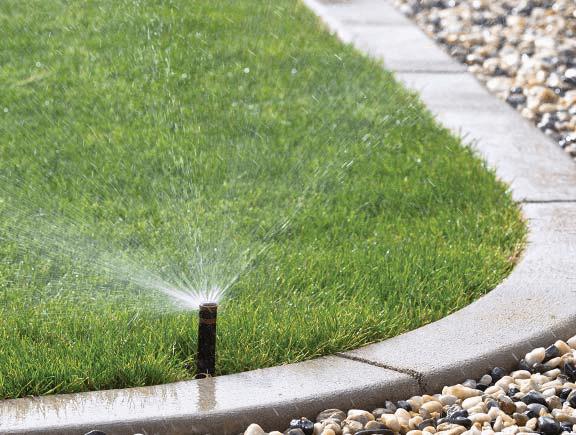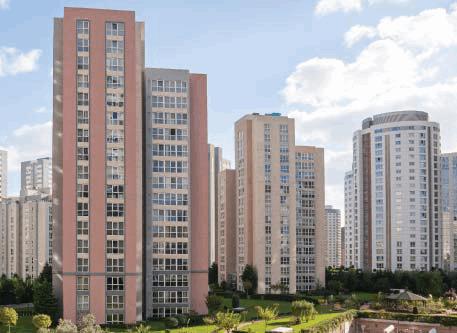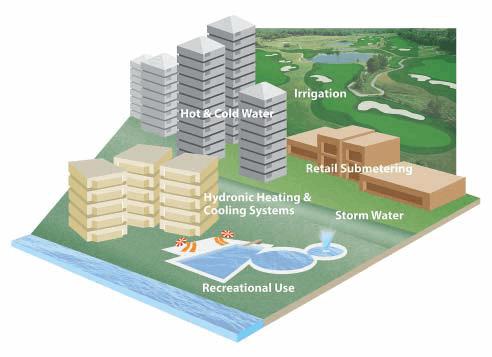Flow Measurement Management Enables Total Visibility Of Water Use
By Robert J. Fehl
Advancements in submetering and cloud-based data analytics help reduce consumption, lower costs, and improve operational efficiency.
Today, there is an urgent demand for accountability and water conservation. To meet these challenges, facility owners need more data — intelligent data. And they need it delivered quickly.
This article describes solutions for total visibility of water use at commercial and industrial sites. The latest technology advancements in submetering, including flow measurement dashboards and cloud-based analytics, provide the means to ensure proactive leak detection and detailed consumption information, conserve resources, reduce lost water, and improve operational efficiency.
Introduction
Water is an essential substance in the modern world. It is used for heating, ventilation, and air conditioning (HVAC) systems, manufacturing, irrigation, sanitation, and more. However, there is a common misperception that water supplies are abundant thanks to plentiful precipitation and that storage is unlimited. Due to climate change and population growth, there is a critical need to use water more efficiently.
Studies have shown that global water demand will increase 55 percent by 2050.1 For this reason, national and local governments are mandating strict water conservation measures. For example, U.S. government agencies must reduce their potable water consumption by 2 percent yearly through 2020 over their 2007 baseline.2 The State of California has enacted a 20 percent reduction in water use by 2020 over its 2005 baseline.3
According to a recent United Nations report, up to 65 percent of reduction in water and energy use is possible in some American cities via efficient water appliances, leak reduction, and use of dry landscaping.4

Due to climate change and population growth, there is a critical need to use water more efficiently.
Importance Of Submetering
Fast, easy access to powerful water-use information is imperative for organizations of all sizes. In fact, increasing government regulations, natural resource scarcity, emerging environmental concerns, and growing cultural awareness make it essential.
Most facility owners/ managers are interested in reducing water consumption on their properties, although they lack information on how to accomplish the desired reductions and — particularly at the smaller facilities — the time to develop and maintain efficient systems.
With increased water rates in many regions, commercial and industrial sites are motivated to reduce usage levels and, at the same time, identify leaks and equipment malfunctions. They require accurate systems to assess overall water consumption patterns and help identify areas for improvement and water-efficient best practices. These efforts can contribute to the broader sustainability goals of an organization.
With traditional submetering, water supplied to a facility or property first goes through the primary meter (also known as the master meter), which measures and provides information on the total volume of water consumption. The limitation of a master meter is that it does not reveal how much and where water is consumed within the location.

Commercial and industrial sites are motivated to reduce usage levels and, at the same time, identify leaks and equipment malfunctions.
In some cases, submeters are installed to measure the consumption of specific, water-intensive fixtures such as boilers and irrigation systems. This approach allows facility owners and/or managers to collect the water consumption data of each fixture on their property and thus identify water conservation opportunities.
However, large properties, such as buildings, resorts, and factories, can present unique submetering and cost-recovery challenges. The common barriers to this technique include:
- Installation cost and high, recurring maintenance expenses
- Monthly service charge for specialized assistance with meter reading and allocation
- Regulatory issues involving permits, inspections, and fees for submetering equipment
- Liability concerns related to system malfunction, leaks, etc.
Despite these issues, there are significant incentives for implementing an effective submetering solution. Submetering throughout a facility, property, or campus empowers everyone from management to operations staff to make more knowledgeable decisions for more efficient use of valuable fluid resources. It can help facility management address both corporate sustainability goals and rising water costs by monitoring usage levels and implementing water-saving changes to their operations (see Figure 1).
Latest Technology Developments
Submetering is normally the best way to get a handle on water consumption. While simply installing submeters is effective alone, using advanced water data management technology can quickly optimize any submetering program, making current, exact usage data available to appropriate stakeholders. This, in turn, can reduce water consumption by:
- Raising awareness of how much water is consumed over time
- Ensuring compliance with local water usage restrictions
- Stemming waste from malfunctioning systems
By providing facility managers with real-time, automatically generated data, cloud-based software solutions can make monitoring, billing, and reducing water use far easier than with traditional, manual submetering systems. The latest metering systems can analyze consumption on a real-time basis, making it simple not only to track where and when small leaks occur, but also to track patterns of water consumption. In either instance, it allows facilities to be more proactive in addressing consumption-related issues.
The current generation of web-enabled flow measurement management system packages advanced software with proven flow measurement technologies and leverages existing cellular network infrastructure for improving management of facility water resources, including domestic hot and cold water, irrigation systems, recreational usage, tenant submetering, HVAC systems, etc. Users often integrate the software platform with other operations and process systems via an application programming interface (API), utilizing secure encryption to ensure data is reliably transmitted and received.
Advancements in targeted metering analytics bring new optimizing information to light and put interval meter data to work to address requirements for actionable intelligence and improved operations. New analytic tools offer an overview of the water system through a standard web browser and provide robust status and trend information.
The latest end-to-end software solutions include an integrated “dashboard” format with key performance indicators (KPIs) to provide displays, graphs, and charts with crucial data. In addition to delivering fully time-synchronized reads on water consumption, they can generate immediate priority alarms for minor and major flow events, as well as continuous leaks. O&M (operations and maintenance) personnel can view and track water usage online via a computer or mobile device. System displays provide analytics and graphs that incorporate historical data, such as temperature and rainfall overlays, to create a clear picture of how water is currently being used throughout the facility.
Intelligent data and analytics applications also empower users at various levels of an organization to identify and quickly address flow inefficiencies, equipment problems, or wasteful behaviors. Their data tools make detailed consumption statistics easily accessible, enabling fast response to inquiries and quick resolution of issues.
Finally, the use of cellular endpoints minimizes the need for complicated infrastructure. Such endpoints may be set up to automatically broadcast meter-reading and event data to system software on a predetermined schedule. This information helps identify potential anomalies in water use. Alert conditions can even be created to monitor and notify users of system exceptions, including continuous flow for faster leak detection. Facility operators are able to determine the number and percentage of endpoints reporting with and without issues, as well as view a list of endpoints with reported issues.
Benefits To Facility Owners
The submetering of commercial and industrial sites, through the refined measurement of water usage, provides the O&M transparency necessary for more efficient management of valuable resources. Furthermore, submetering has proven to drive behavioral change related to conservation efforts. Each of these potential benefits can dramatically improve operational efficiency and sustainability and lead to significantly decreased consumption levels.
For facility owners and managers, a detailed record of water system performance data is useful to not only detect malfunctions, but also to focus future design and retrofit activities on the most cost-effective improvements.
The specific benefits of deploying advanced submetering technology include:
- Fast leak detection
- Identification of problematic equipment
- Cost reduction via efficiency gains
- Recognition and correction of wasteful behaviors
- Reduction of risk and liability of major leaks
The new breed of flow measurement management systems allows facilities to manage, monitor, and troubleshoot a variety of field-based assets via any web-enabled device while storing data in a cloud-based data warehouse. By integrating remote management, flow measurement, and leak detection capabilities, they are able to provide a comprehensive water management capability for facilities’ professionals.

Figure 1. Submetering can address both corporate sustainability goals and rising water costs by monitoring usage levels and implementing water-saving changes to operations.
Conclusion
Water submetering at commercial and industrial sites represents an important first step toward quantifying over time the point sources that can drive resource efficiency and conservation activities. It is an enabling technology with significant potential value in new design or upgrading existing facilities.
Today’s advanced, cloud-based software solutions are a valuable tool for supplying facilities with real-time water performance data, highlighting variations over time or in comparison to other facilities, providing accurate and real-time information to automation systems, and supporting behavioral and operational changes by facility operators and occupants.
References
- OECD Global Forum on Environment: Making Water Reform Happen (2011). Water: The Environmental Outlook to 2050 [Data file]. Retrieved from https://www.oecd.org/env/resources/49006778.pdf
- FedCenter (2015) [Data file]. Retrieved from https://www.fedcenter.gov/programs/eo13514/
- California Department of Water Resources (2010). 20x2020 Water Conversation Plan [Data file]. Retrieved from http://www.water.ca.gov/wateruseefficiency/sb7/docs/20x2020plan.pdf
- UNESCO. United Nations World Water Assessment Programme [Data file]. Retrieved from http://unesdoc.unesco.org/images/0022/002257/225741E.pdf10
About The Author
 Rob Fehl represents The Water Council — a nonprofit collaborative between public, private, and academic sectors that drives economic, technology, and talent development in the water industry — through his work at member company Badger Meter, Inc. Rob began his career at Badger in 1991 and is now marketing product manager for the commercial and industrial product line. He earned an associate’s degree in mechanical design from Waukesha County Technical College, as well as business and engineering training from the University of Wisconsin-Milwaukee and the Milwaukee School of Engineering.
Rob Fehl represents The Water Council — a nonprofit collaborative between public, private, and academic sectors that drives economic, technology, and talent development in the water industry — through his work at member company Badger Meter, Inc. Rob began his career at Badger in 1991 and is now marketing product manager for the commercial and industrial product line. He earned an associate’s degree in mechanical design from Waukesha County Technical College, as well as business and engineering training from the University of Wisconsin-Milwaukee and the Milwaukee School of Engineering.
